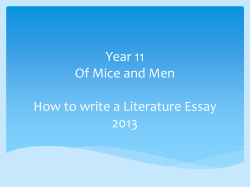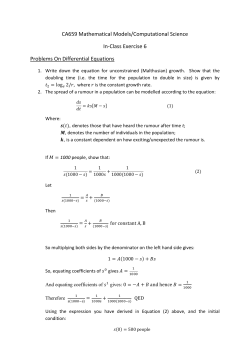
High Schools - Parma City School District
Of Mice and Men Study Guide Author Biography John Steinbeck (1902-1968) was born in Salinas, California. He came from a middle class family. His father was the county treasurer, and his mother was a former schoolteacher. She inspired and encouraged his love of books and reading. He attended Stanford University, but he did not graduate. In his twenties, he traveled to New York City with the dream of supporting himself as a freelance writer. When his efforts failed, he went home to California. He then began to work seriously on novels and short stories. When Steinbeck was a young adult, he spent his summer vacations working as a hired hand on local ranches. His interactions with the people he met during those summers greatly influenced the characters he created throughout his career. In an interview following the publication of Of Mice and Men, Steinbeck revealed that all the characters in the novel are composites based on real people. Steinbeck said in his essay “Advice For Beginning Writers” (1963) that he still felt afraid every time he began writing a story, even though he had a long successful writing career behind him. He went on to say that a writer who does not experience this fear may not have an appropriate respect for the art of writing. Book Summary Background Of Mice and Men was published in 1937, after John Steinbeck had achieved literary acclaim with his novel Tortilla Flat but before he wrote his better known works The Grapes of Wrath and East of Eden. The story epitomizes the themes and ideas that Steinbeck propounded throughout his novels: the plight of the laborers, the perils of isolation, and the hope for a better future. Set in California during the Great Depression, Of Mice and Men is an excellent vehicle to learn about the life and times of migrant works in the 1930s. With its beautiful descriptive passages, easily accessible dialogue, and fast-paced timeline, it is very easy to follow along. Readers are drawn in by the memorable characters, that, ironically, represent a segment of society that was largely ignored in its day. Analyzing the balance of power, the importance of friendship, and the role of dreams in our lives allows readers to gain a deeper understanding of the text while applying valuable lessons to their own lives. Novel Setting Of Mice and Men is set in the Salinas Valley of Southern California in the late 1930’s, the era of the Great Depression. Like many writers of the Modern Period (1915-1945), John Steinbeck attempts to make sense of the early decades of the 20th century; he sees the humanity in a class of people who are often ignored by writers and by society at large. These issues are further developed in Steinbeck’s The Grapes of Wrath. Character List Below is a list of the major characters from Of Mice and Men. Lennie Small: a nondescript, hulking creature of a man whose childlike mentality continually gets him into scrapes with men who neither respect nor understand him. George Milton: a small, lean man, used to fighting for his place in the world. He oversees and protects Lennie. Slim: a tall skinner (a highly skilled mule-driver) that serves as a counselor to the ranch hands. Candy: The one-handed ranch worker who has lived past his prime. Curley’s wife: never named, she is not respected by the men on the ranch. Crooks: the African-American stable buck is called Crooks because of a spinal injury inflicted by a kicking horse. Curley: the boss’ son, he possesses a jealous, cruel streak. Synopsis John Steinbeck’s novel Of Mice and Men places the reader in Depression-era California, traveling from job to job with two migrant laborers, George Milton and Lennie Small. The novel explores their friendship, in contrast to the isolation of their peers, and the way dreams can either sustain or discourage people. It also addresses a variety of issues, including racism, sexism, and other forms of discrimination, that play out against the backdrop of lonely people seeking happiness. In addition examining important ethical dilemmas, studying Of Mice and Men provides an opportunity to discuss literary devices such as foreshadowing, symbolism, and point of view. Setting Setting is determining time, place, and tone in fiction. This activity helps you see that the setting at the beginning of each scene establishes the atmosphere for the scene. Directions: Read the following passage from the beginning of the first section. Circle five examples of descriptive language that develop and establish the atmosphere of the first section. In the space below, explain how the descriptions you circled build atmosphere. “A few miles south of Soledad, the Salinas River drops in close to the hillside bank and runs deep and green. The water is warm too, for it has slipped twinkling over the yellow sands in the sunlight before reaching the narrow pool. On one side of the river the golden foothill slopes curve up to the strong and rocky Gabilan mountains, but on the valley side the waters is line with trees – willows fresh and green with every spring, carrying in their lower leaf junctures the debris of the winter’s flooding; and sycamores with mottled, white, recumbent limbs and branches that arch over the pool. On the sandy bank under the trees the leaves lie deep and so crisp that a lizard makes a great skittering if he runs among them. Rabbits come out of the brush to sit on the sand in the evening, and the damp flats are covered with the night tracks of ‘coons, and with the spread pads of dogs from the ranches, and with the split-wedge tracks of deer that come to drink in the dark.” 1. 2. 3. 4. 5. Section 3 Thematic Analysis A theme is a general concept or idea, such as love, justice or sorrow. One way to help you think of themes is to complete the following sentence: “This is a book about _________________.” The theme of the American Dream permeates John Steinbeck’s Of Mice and Men; several of the major characters seek a version of the American Dream. Directions: Answer the following questions in complete sentences. What is the “American Dream”? Specifically, what “American Dream” are each characters persuing? Use examples from the book (with page numbers). George Lennie Candy Literary Analysis: Point of View The point of view is the way that the narrator sees the events in the story. Of Mice and Men is written from an objective, third-person point of view. The benefit of this choice is the reader is aware of everything that happens in the novel. The drawback is that the reader cannot enter into the thoughts and emotions of any one character. Use this opportunity to explore the effects of using a first-person point of view from the story. Directions: In the space provided, rewrite one page from Section 3 in the first person (use I, me, my). View the scene through the eyes of any of the following characters: George, Slim, Lennie, Carlson, Candy, Crooks, or Curley. Add feelings and ideas that are consistent with the character’s personality. Include the page reference for the passage you are rewriting. First-Person Rewrite: Section 4 Character Analysis: Crooks Characterization is the method used by a writer to develop how the character looks, acts, and thinks. Finding connections is one way to improve your critical thinking skills. Directions: Read the following passage, then respond to the questions to understand how one character fits into the novel. Crooks laughed again. “A guy can talk to you an’ be sure you won’t go blabbin’. Couple of weeks an’ them pups’ll be all right. George knows what he’s about. Jus’ talks, an’ you don’t understand nothing.” He leaned forward excitedly. “This is just a nigger talkin’, an’ a busted-back nigger. So it don’t mean nothing, see? You couldn’t remember it anyways. I seen it over an’ over – a guy talkin’ to another guy and it don’t make no difference.” His excitement had increased until he pounded his knee with his hand. “George can tell you screwy things, and it don’t matter. It’s just the talking. It’s just bein’ with another guy. That’s all.” Do Crooks’ thoughts in this passage reflect any of the thoughts of the novel’s other characters? How does Crooks’ race contribute to his outcast nature? What is the significance of talking to “another guy” to Crooks? Why does Crooks emphasize hiss race in this passage? What would it take for Crooks to feel any degree of acceptance among the workers? Symbolism: Defining the Characters A symbol is an object or action that stands for something else. After finishing Section 4, you have learned a great deal about each of the character’s personalities. In this assignment, demonstrate your understanding of one character through the use of symbolism (for example, choose an object that represents one aspect of your character). This activity asks you to apply your knowledge of symbolism and of the story. Directions: Follow the steps below. Step 1: Choose a character from the novel and write his/her name here: _________________________ Step 2: Consider this character’s personality and behavior. Which trait do you feel is the most important one? Write it here: Step 3: Choose an object that represents the personality trait described above. Think outside the box. What object will you use to symbolize your character? Write it here: Step 4: In the space below, describe how your object represents the character’s personality trait. You may use note form or use complete sentences. Write your explanation here: Section 5 Thematic Analysis: Dreams A theme is a general concept or idea, such as love, justice, or sorrow. One way to help you think of themes is to complete the following sentence: “This is a book about _____________________.” One of the major themes in Of Mice and Men is the elusiveness of dreams; several characters’ hopes have been dashed by the end of Section 5. Directions: Identify the dream of each of the following characters, and explain how that dream is destroyed. Explain what you can learn from this at the bottom of the page. George and Lennie Dream: How it dies: Crooks Dream: How it dies: Candy Dream: How it dies: Curley’s Wife Dream: How it dies: Lessons Learned What message is the author giving the readers? Will anyone’s dream come to fruition? How do you feel after examining this rather depressing theme? Section 6 Symbolism Symbols, objects that represent other things, are significant literary elements; they become a type of shorthand for particular ideas or concepts in a piece of literature. Directions: The following are recurring symbols in Of Mice and Men. Explain how the symbols are alike and what they represent. the rabbits as symbols of George and Lennie’s dreams the fate of Candy’s dog as a symbol of Lennie’s ultimate fate and human tragedy the color red as a symbol of danger or trouble the bunk house as a symbol of danger for Lennie Curley’s wife as a symbol of women of the early twentieth century
© Copyright 2025










